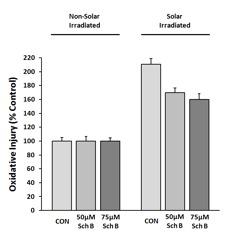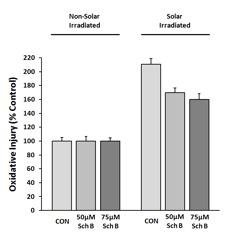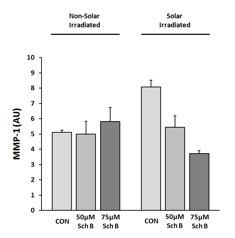Introduction
Schisandrin B, a key component of Glissandrin, can protect against solar irradiation-induced oxidative injury in skin tissue and skin cells, according to recent research findings from the laboratory of Dr. Robert Ko at the Hong Kong University of Science and Technology.
As the largest organ in the human body, the skin serves as an effective barrier for protecting against various external threats. This includes exposure to harmful solar irradiation – particularly UV and infrared rays – which research has shown to be a major cause of skin aging. Solar irradiation-induced reactive oxygen species (ROS) generation is responsible for photo-aging, the signs of which include wrinkles, coarse skin texture, and reduced skin resilience. Although human skin tissue possesses non-enzymatic and enzymatic antioxidant defense systems to cope with the increased oxidative stress caused by solar light radiation, long-term exposure or over-exposure to solar light can overwhelm the antioxidant system.
But what if there was a way to enhance the skin’s natural antioxidant defenses to prevent photo-aging entirely? Schisandrin B (Sch B) is able to do just that, ushering in a new era in UV protective skincare.
Schisandrin B is derived from the Schisandra fruit, an herb commonly used in Traditional Chinese Medicine (TCM). This naturally occurring herbal ingredient has been found to produce tissue non-specific protection against oxidative injury by enhancing cellular and mitochondrial glutathione antioxidant status in the heart, liver, kidney, and brain.

Figure 1: Schisandra berry
Recent studies led by Dr. Robert Ko at the Hong Kong University of Science and Technology have shown the promise of Schisandrin B:
• Schisandrin B stimulated both reduced-glutathione and vitamin E levels. These two non-enzymatic antioxidants can remove excess ROS during oxidative stress in a synergistic manner.
• Schisandrin B elevated various enzymes involved in the enzymatic antioxidant defense system, demonstrating that non-enzymatic and enzymatic antioxidant components work together to protect against solar irradiation-induced oxidative injury in skin tissue.

Figure 2: Effects of Sch B pretreatment on solar irradiation-induced cell injury in BJ human fibroblasts
• Schisandrin B suppressed the solar irradiation-induced increases in elastases-type protease activity and matrix-metalloproteinases-1 (MMP-1) expression in skin cells. The degradation of the extracellular matrix (EM) in skin tissue as a result of solar irradiation is of prime concern in skincare. This is one of the major biological events that leads to photo-aging and is mediated by protein-degrading enzymes like elastases-type protease and MMP-1.

Figure 3: Effects of Sch B pretreatment on cellular elastases-type protease activity in solar-irradiated BJ human fibroblasts

Figure 4: Effects of Sch B pretreatment on cellular MMP-1 level in solar-irradiated BJ human fibroblasts
Schisandrin B is a key component of Glissandrin™, a potent anti-aging skincare ingredient that has been the subject of over 100 research papers. In-vivo and in-vitro studies have proven the ability of Glissandrin to reverse mitochondrial decay , the leading cause of aging, and to simultaneously enhance the cell’s natural ability to fight oxidative damage.
Other studies have shown the ability of Schisandrin B to suppress collagenase, an enzyme responsible for the depletion of collagen in skin cells. Research has also been conducted on the compound’s anti-cancer properties, particularly in the skin.

Figure 5: Mitochondria
Conclusion
Given that both spectra of solar light – UV and infrared radiation – are major causes of skin aging, Schisandrin B’s ability to enhance the skin’s antioxidant defenses against harmful solar irradiation, thereby offering the prospect of preventing skin photo-aging, is instigating a new era in skincare.
For more information
More information on Schisandrin B, mitochondrial decay, and theories of aging can be found at these independent websites:
• National Institutes of Health (http://www.nih.gov/)
• PubMed (http://www.ncbi.nlm.nih.gov/pubmed/)
• Natural Standard (http://www.naturalstandard.com/)
Background and References
Schisandrin B is a key component of Glissandrin™, the proprietary ingredient in Glissandra™ products.
Dr. Robert Ko holds a PhD from the University of British Columbia in Vancouver, Canada. He is currently a Professor in the Division of Life Science at the Hong Kong University of Science and Technology, and Chief Technology Officer of Glissandra Skincare Inc.
The Hong Kong University of Science and Technology is ranked 41st among research universities worldwide by Times Higher Education 2010 (London, UK).
Lam PY, Leong PK, Chen N, Ko KM: Schisandrin B enhances the glutathione redox cycling and protects against oxidant injury in different types of cultured cells. Biofactors (in press).
Chiu, P.Y., and Ko, K.M. (2006). Schisandrin B-induced increase in cellular glutathione level and protection against oxidant injury are mediated by the enhancement of glutathione synthesis and regeneration in AML12 and H9c2 cells. Biofactors 26: 221-230.
Chiu, P.Y., Leung, H.Y., and Ko, K.M. (2008). Schisandrin B enhances renal mitochondrial antioxidant status, functional and structural integrity, and protects against gentamicin-induced nephrotoxicity in rats. Biol. Pharm. Bull. 31: 602-605.
Chen, N., Chiu, P.Y., and Ko, K.M. (2008). Schisandrin B enhances cerebral mitochondrial antioxidant status and structural integrity, and protects against cerebral ischemia/reperfusion injury in rats. Biol. Pharm. Bull. 31: 1387-1391.
Lam PY, Yan CW, Chiu PY, Leung HY, Ko KM. Schisandrin B protects against solar irradiation-induced oxidative stress in rat skin tissue. Fitoterapia 2011; 82: 393-400.
Chiu PY, PY Lam, Yan CW, Ko KM. Schisandrin B protects against solar irradiation-induced oxidative injury in BJ human fibroblasts. Fitoterapia 2011; 82: 682-691.
Nisida H, Tatewaki N, Magara T, Nakajima Y, Ko KM, Hamamori Y, Konishi T: Inhibition of ATR kinase activity by schisandrin B in DNA damage response. Nucleic Acid Res. 2009; 37: 5678-5689.
